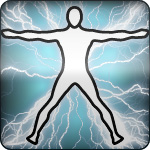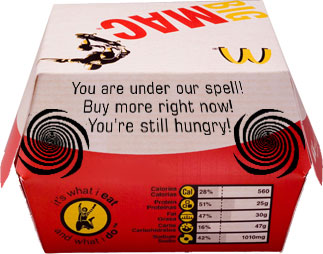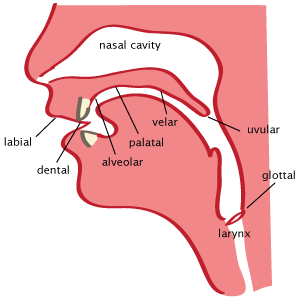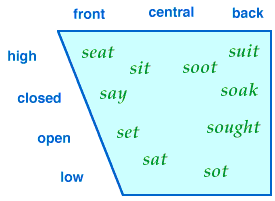NLP Weight Loss
Weight Loss can not be achieved with NLP - but NLP can help you change your habits so that you can easily lose weight. What if celery tasted like chocolate? What if going for a run felt better than going to the pub? How easy would it be to lose weight?

Weight loss is not magic. You simply intake less energy than you output. NLP for weight loss is not magic either. You cannot convince yourself that you are losing weight using NLP, then go eat a tub of icecream. But you can use NLP to acheive weight loss by making that icecream seem unappealing.
Ice cream is delicious, right? How can it possibly become
 unappealing? The truth is, the pros of icecream just outweigh the cons. You have to concentrate on the cons, not the pros. Think about that fatty aftertaste it leaves in your mouth. See that fatty aftertaste as a visible, irremovable film that sticks like glue to your mouth. Picture the cold, hard sugars rotting away at your teeth until they become painful and brown. Visualise the fat globules seeping through your insides, gooping their way through your blood vessels and adding themselves into heaving, pale yellow piles of fat under your skin. Imagine the sound of all the saturated animal fats congealing into a sickly putty and clogging up your arteries. How do you imagine that processed fat smells once it's stripped of its artificial flavours and sugars?
unappealing? The truth is, the pros of icecream just outweigh the cons. You have to concentrate on the cons, not the pros. Think about that fatty aftertaste it leaves in your mouth. See that fatty aftertaste as a visible, irremovable film that sticks like glue to your mouth. Picture the cold, hard sugars rotting away at your teeth until they become painful and brown. Visualise the fat globules seeping through your insides, gooping their way through your blood vessels and adding themselves into heaving, pale yellow piles of fat under your skin. Imagine the sound of all the saturated animal fats congealing into a sickly putty and clogging up your arteries. How do you imagine that processed fat smells once it's stripped of its artificial flavours and sugars? How does that icecream sound now? Read that paragraph out loud if you need to. The more vividly you imagine these things, the better they will work. For added effect, you would read this out while a plate of icecream is sitting in front of you. Take one spoonful, put it in your mouth, and start reading. Focus on the bad aspects of the food, and they will soon outweigh the good aspects. The result is that you won't be buying more icecream next time you're at the supermarket.
Making Healthy Eating more Appealing with NLP
 The same goes for any food you like but probably shouldn't eat. And the reverse goes for food you don't like to eat. Let's take celery, for example. Celery is great because it actually requires more calories to break it down and process it than it contains.
The same goes for any food you like but probably shouldn't eat. And the reverse goes for food you don't like to eat. Let's take celery, for example. Celery is great because it actually requires more calories to break it down and process it than it contains.Think about that. Every fresh, crisp piece of celery you bite off and chew, goes into your body and melts down fat. Not directly, of course, but for the purpose of our NLP learning let's pretend it does. In reality, your fat deposits are broken down by your body to gain energy for the processing of the celery. But I digress.
What is your favourite aspect of celery? If you hate the taste, then use a different vegetable for this example, possibly a carrot or piece of lettuce. Picture the celery being nicely broken down and literally turning old fat deposits into pure water. Concentrate on the taste. Say words like "mmm delicious!" and really mean them. Act like it is the most delicious piece of food you have eaten in your entire life. Tell other people how great it tastes. Even if you don't quite believe yourself, put on the performance of a lifetime.
Your body will react by genuinely starting to like celery. This is the exact method I used on olives, which I used to hate but now very much enjoy. The more times you put on this act, and the more emotion you put behind your act, the faster this will work.
How Does This NLP Secret Work?
These NLP processes essentially work by tricking your brain into reconfiguring its reaction to certain foods. You are literally telling your brain that it is wrong, it's giving the wrong signals. Your brain will react by correcting these problems in your favour. As soon as you take your bite of celery...| Your Frontal Lobes (prefrontal cortex) gives the conscious signal to your body to act like you are enjoying the celery like it's the best thing on earth. | ||
| Your Insula immediately tells you that is this is boring, distasteful old celery. It replays the same old taste sensations that you're used to. | ||
| But what's this?! Your Temporal Lobes and Parietal Lobes are behaving oddly. They seem to be creating reflex signals that indicate great enjoyment. How strange! | ||
| Since you have requested information on how to act when eating an enjoyable food. The Amygdala is giving out faint emotions of pleasure, to tell the other active brain parts what emotions to simulate. The more you get into the act, the stronger the sensation will become. | ||
| The hippocampus matches this feeling with pleasurable eating, and it matches the current sensory input with that of eating celery. It confirms you are eating celery. | ||
| Your Insula stands confused but corrected, and processes this pleasurable information and builds new pathways to link directly to the other corresponding parts of the brain. | ||
Obviously there are millions of other things going on in your brain, but these are the points we're interested in. Also obviously, this will not automatically and permanently change your perception of celery. You've only built 1 new pathway, compared to all the other thousands of times you've eaten celery and reacted naturally. Therefore the more times you repeat this act, the stronger its effect will be and the easier and more natural the act will become.
Eventually you will develop a genuine taste for celery. I have always liked celery, but I used this technique on olives (as I already mentioned) and now I consider olives a delicious treat.
 Gathering motivation to exercise is hard. NLP can make it much easier |
Going for a Run or Sitting in front of the TV?
The exact same principle applies. To prefer exercise or energy-consuming activites over sedentary activites, you need to rewire your brain a little bit. Again, this is entirely possible, and really not too different from learning to pronounce a word I've been mispronouncing my entire life, thank you minotaur.When you think "should I go exercise?" what is the first thing you picture? You picture yourself doing the exercise in question, and asking yourself how you would feel doing that. The answer is probably "I'd feel tired, I'd need to put in a lot of effort and energy, it seems a bit too much like hard work." No! Your brain doesn't tell YOU how to think! YOU tell your BRAIN how to think!
Think "Should I go exercise" and immediately picture yourself having acheived a specific goal. If you don't already have a goal, set one now. Imagine you are looking at a Youtube clip of yourself in the future, the very moment you acheive that goal. Click on "play video" and see the screen displaying future you competing that goal for the first time. Close up on your face, see your expression as you acheive that goal. Listen to your breathing and see the sense of acheivement spread across your face. Now step into the video and click "replay". Act it out in your mind - how does it feel?
How tempting does that exercise sound now?
NLP to Increase Enjoyment of Exercise
Goal acheivement visualisation works. I use this on all my martial arts students and you can see a significant change in motivation. It also works being performed during exercise. You can perform the celery trick to increase enjoyment during exercise.When you're running up that steep hill or lifting that heavy weight, what are you thinking? Probably some sort of profanity-infused monologue regarding the unpleasantness of the situation. Why? There is no point.
Enjoy the feeling of the blood coursing through your body! How alive do you feel? Your body is operating on a large scale, this is the kind of thing that kept billions of your evolutionary ancestors alive! Feel the rush of blood, the spirited tempo of your heart, and enjoy it! If you make this your focus and act it out, those endorphins come flooding in.
Personal note:
If you don't exercise regularly, I highly recommend trying it out. It doesn't have to be strenuous. Exercise shouldn't be too uncomfortable, I believe you should start as you mean to go on. If you start too hard too fast you can become overwhelmed and lose motivation. Music can help. Please try some regular exercise for a month and concetrate on enjoying the parts you do enjoy. See how much better you feel after a month.
NLP Weight Loss made Easy
NLP techniques for weight loss take time and concentration, but it is worth the time spent practicing. Or you could just do it Matrix-style and use subliminals. Subliminals are a powerful way to tap into the subconscious mind and change your bad mental habits. The word subliminal itself comes from the Latin words sub (meaning below) and limen (meaning threshold), so it literally translates as below threshold. All this means is that a subliminal message is any piece of information which is received beyond your conscious awareness.In everyday life, you are constantly filtering billions of pieces of information taken in by the five senses. Only a very tiny fraction of this information is processed by the conscious brain. The rest is filtered by the subconscious. For instance, when crossing the street you notice the traffic around you because it's crucial if you don't want to get run over. But when walking on the path you barely notice the cars whizzing past just a few feet away.
Therefore, you are very good at taking in subliminal information already - and the purpose of subliminal technology like the Subliminal Weight Loss MP3 is to give you specific information to achieve your goal of living healthier and losing weight. Your body will not subconsciously throw off the fat without any conscious effort - BUT you will want to behave differently when you program your subconscious mind to think differently. I highly recommend the instant downloads over at Subliminal MP3s to begin your NLP programming.
 The subject of lying, or more specifically, how to tell if someone is lying, is something that I can write a lot about. Being both an accomplished liar and lie detector is something a lot of people want to know how to do. Learning how to tell if someone is lying is difficult, but learning how to lie convincing is more difficult. Lying is never a clear case - there are certainly powerful indicators but no 100% methods - which is why there are no true lie detectors usable in a court of law. But with a bit of practise, you can easily become the next best thing.
The subject of lying, or more specifically, how to tell if someone is lying, is something that I can write a lot about. Being both an accomplished liar and lie detector is something a lot of people want to know how to do. Learning how to tell if someone is lying is difficult, but learning how to lie convincing is more difficult. Lying is never a clear case - there are certainly powerful indicators but no 100% methods - which is why there are no true lie detectors usable in a court of law. But with a bit of practise, you can easily become the next best thing.


 NLP masters I would define as those who have truly understood the mechanics of NLP, taken it to its thoroughbred level, show us the awesome capabilites of NLP and thus inspire us to master NLP ourselves. NLP masters (or NLP gurus) are always very positive people who help others develop the tools to become positive themselves. Positive people have positive lives, this is undeniable. Sure, some of the masters have made a ridiculous amount of money doing what they do - but do they not deserve it?
NLP masters I would define as those who have truly understood the mechanics of NLP, taken it to its thoroughbred level, show us the awesome capabilites of NLP and thus inspire us to master NLP ourselves. NLP masters (or NLP gurus) are always very positive people who help others develop the tools to become positive themselves. Positive people have positive lives, this is undeniable. Sure, some of the masters have made a ridiculous amount of money doing what they do - but do they not deserve it? Tony Robbins is an American motivational speaker and successful self-help author. He is widely regarded as the most successful motivational speaker in the world. He has helped millions of people all over the world achieve their personal goals and improve their quality of life.
Tony Robbins is an American motivational speaker and successful self-help author. He is widely regarded as the most successful motivational speaker in the world. He has helped millions of people all over the world achieve their personal goals and improve their quality of life. Once the host of his own TV show The Hypnotic World of Paul McKenna, and street hypnosis show Street Hyp, Paul McKenna is perhaps now best known for his range of books, including bestsellers I can make you thin and I can make you rich. Paul's books are published in 30 languages, all over the world.
Once the host of his own TV show The Hypnotic World of Paul McKenna, and street hypnosis show Street Hyp, Paul McKenna is perhaps now best known for his range of books, including bestsellers I can make you thin and I can make you rich. Paul's books are published in 30 languages, all over the world. Although Derren Brown is most famous for his fascinating television shows broadcast in the UK, he has a solid reputation for his unequaled development of NLP and hypnosis. In fact, Derren's effortless demonstration of NLP to manipulate the thoughts of his guest stars was what got me interested in NLP in the first place!
Although Derren Brown is most famous for his fascinating television shows broadcast in the UK, he has a solid reputation for his unequaled development of NLP and hypnosis. In fact, Derren's effortless demonstration of NLP to manipulate the thoughts of his guest stars was what got me interested in NLP in the first place!

 How to I explain how to hypnotize someone? First we must understand what hypnosis is. Hypnosis is not what many people think it is. A hypnotic trance is not a brain-dead, obey-all zombification during which you are completely unaware of your surroundings. Hypnosis does not usually induce a deep catatonic state, although with enough patience and the right subject, it can create an analog catatonia.
How to I explain how to hypnotize someone? First we must understand what hypnosis is. Hypnosis is not what many people think it is. A hypnotic trance is not a brain-dead, obey-all zombification during which you are completely unaware of your surroundings. Hypnosis does not usually induce a deep catatonic state, although with enough patience and the right subject, it can create an analog catatonia. Models
Models


